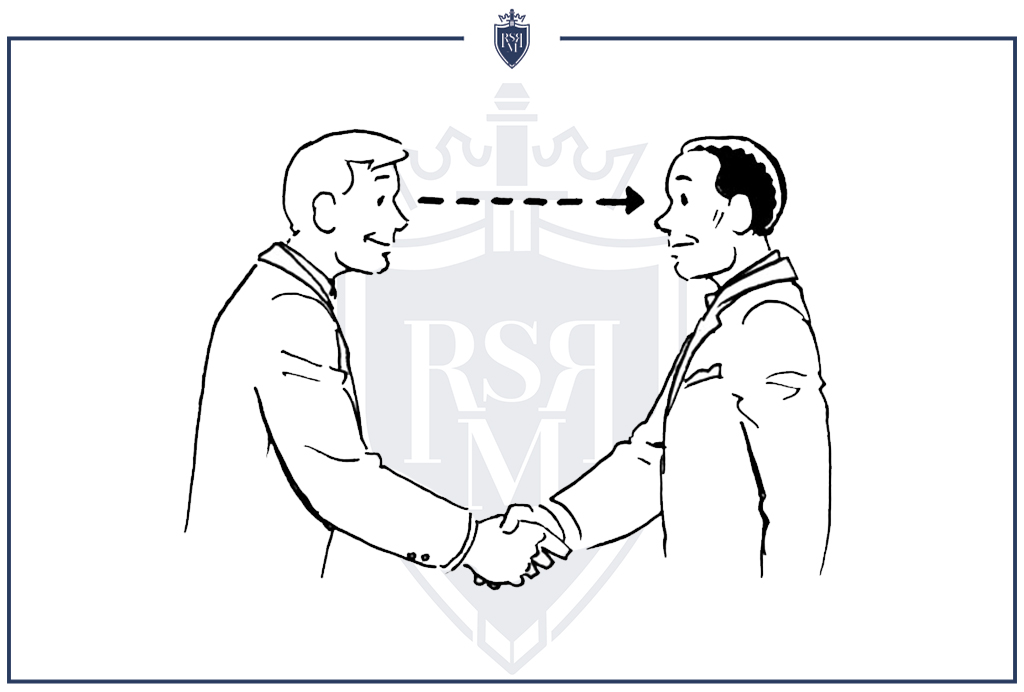If you want someone to remember your word – follow the eye contact rules.
A joint 2006 study between the University of Wolverhampton and the University of Stirling found that making eye contact even 30% of the time increases people’s ability to remember what you say.
In this article, we're giving you 21 eye contact rules.

They are:
- Make Enough Eye Contact
- Don't Make Too Much Eye Contact
- Look For 3-5 Seconds
- Hold Eye Contact To Make People Tell You The Truth
- Movement + Eye Contact = Memorable
- Know How Much Eye Contact To Make With Authority
- Establish Eye Contact At The Start
- Making Eye Contact In Different Cultures
- Keep It Fair
- Don’t Assume She Likes You If She Looks At You
- Don’t Assume She Hates You If She Doesn’t Look At You
- When You Meet A Woman’s Eyes – Smile
- Don’t Stare At Breasts
- ‘Sticky Eyes’ Are Attractive
- Know Where To Look
- Blinking (Don’t Blink Too Much During Eye Contact)
- Show You’re Listening When You’re Not Looking
- For Short Requests, Make More Eye Contact
- For Long Speeches, Make Less Eye Contact
- Understand Children Find Eye Contact Hard
- ‘Smize’ – Smile With Your Eyes
- Some ways you can practice proper eye contact
Eye Contact Rule #1 – Make Enough Eye Contact

If you live in the U.S. or Canada, follow the 50/70 rule.
Studies at Michigan State University found you should look someone in the eye 50% of the time while speaking to them, and 70% while listening.
Eye Contact Rule #2 – Don't Make Too Much Eye Contact

If you go over the 50 or 70% you can come off as aggressive. I’ve even gotten flack for looking too much at the camera in my videos.
Eye Contact Rule #3 – Look For 3-5 Seconds

In North America, you should look at people for 3-5 seconds at a time if you want to look confident.
Less appears timider, more appears aggressive.
If you're not sure how long 3 seconds is, try counting 1-Mississippi, 2-Mississippi, 3-Mississippi in your head.
Exception: If you’re making eye contact with a woman you don't know, go for 1-2 seconds.
Eye Contact Rule #4 – Hold Eye Contact To Make People Tell You The Truth

Research out of Tufts University found that eye contact makes people more honest.
So if you’re buying a car or dealing with someone you think is shady, look them in the eyes.
Eye Contact Rule #5 – Movement + Eye Contact = Memorable
Two researchers working out of Radboud University and Rutgers University found that eye contact, coupled with a sudden movement (such as an out-of-nowhere hand motion or a turn of the head while you make eye contact) makes people both more memorable and more noticeable.
Eye Contact Rule #6 – Know How Much Eye Contact To Make With Authority

Study how to make eye contact with authority before you start a new job – or better yet before you go to a job interview.
Take into account the setting, the culture, and the background of your employers.
Bosses tend to make more eye contact with workers they see as high performers and avoid eye contact with workers they see as lower status (Journal of Nonverbal Behavior, 2010).
Male bosses are more likely to do this.
Eye Contact Rule #7 – Establish Eye Contact At The Start

To make a confident first impression, before you even start using your voice, establish eye contact with everyone in the room. This is one of the most important eye contact rules if you want to stand out in a crowd.
As a newcomer, it’s YOUR job to break the ice. When you greet people, make eye contact and offer a handshake.
Eye Contact Rule #8 – Making Eye Contact In Different Cultures
The 50/70 rule and 3-5 seconds won’t work in every country:
In many Asian countries (China, India, Pakistan) avoiding eye contact with superiors is a sign of respect.
In Japan, eye contact is seen as rude and it’s more polite to look at the neck.
Some religious groups, such as Muslims, are careful about men and women making eye contact.
Do your homework.
Eye Contact Rule #9 – Keep It Fair

If you’re meeting a group of people, show respect by holding eye contact with each of them for about the same amount of time – even if you know some of them and not others.
Eye Contact Rule #10 – Don’t Assume She Likes You If She Looks At You

Not every woman who looks at you is into you.
Look at the environment – if you're at work maybe she wants to ask you a question about your department.
If you're at a wedding and she's gazing into your eyes, that's different.
Signs she may be into you:
- If she looks away and then looks back for another peek
- If she holds your gaze for a couple of seconds
- And especially if she smiles while looking into your eyes
These are great signs – but you still need to talk to her to find out.
Eye Contact Rule #11 – Don’t Assume She Hates You If She Doesn’t Look At You
Women often avoid eye contact with men because they don’t want to be confused with making an advance.
She may be married, trying to be modest, or she may be used to men being overly aggressive when she does make eye contact.
Don’t force eye contact if she looks like she doesn’t want it.
Eye Contact Rule #12 – When You Meet A Woman’s Eyes – Smile

This is one of the most important eye contact rules. When you make eye contact with a woman you don’t know, give her a smile.
Eye contact AND smiling together are more attractive than eye contact OR smiling alone.
Show you're a nice person. That's all you're looking to do; this is something I think more men could do.
I sometimes still fall into the trap of looking away because it feels awkward – but practice looking at people and smiling.
It’s OK to smile at men too!
Eye Contact Rule #13 – Don’t Stare At Breasts
It needs to be said – when you're speaking to a woman, look her in the eyes.
Women can see when you’re talking to their breasts, and even if they like you – ESPECIALLY if they like you – they want to feel that you're focused on their words.
There are ways that you can train yourself to stop looking elsewhere. Ask yourself her eye color – “Are my coworker Amy’s eyes green or hazel?”
This can also help you recall new names – and if you can actually remember a woman's eye color you're ahead of most guys.
Eye Contact Rule #14 – ‘Sticky Eyes’ Are Attractive
If you want to flirt, when you look away from her turn your head away first, but let your gaze linger a moment longer.
This movement says you find her so desirable it’s hard to tear your eyes away from her—but you respect her too much to gawk.
Use this technique when you're talking to a woman and you have to go. Maintain that eye contact and give her a smile.
It's very attractive to women.
Eye Contact Rule #15 – Know Where To Look

You may find it easier to look at just one of someone’s eyes instead of both, or at the area below the eyes.
For a business associate, imagine a line forming a triangle from their forehead to below their eyes. Keep your eyes in the middle of that triangle.
For someone you know personally, invert the triangle so the middle is in the bridge of their nose. Don’t spend too much time looking at the lower half of someone's face unless you’re flirting.
Eye Contact Rule #16 – Blinking (Don’t Blink Too Much During Eye Contact)
We tend to blink more when we are under stress – so practice looking into people's eyes without blinking too much.
When you’re sending a serious message, less blinking = more credibility.
What's ‘too much?' Anything over about 30 times a minute (once per two seconds).
Remember To Blink
Not blinking looks unnatural. I know – I have this issue. I've been told I look like a robot because I don't blink enough!
What's ‘not enough?' Under 10 times a minute (once per six seconds). Remember to blink and show normal facial expressions and gestures when you're talking. Otherwise, you’ll just come off as staring – and it's rude to stare.
Eye Contact Rule #17 – Show You’re Listening When You’re Not Looking

During the moments you’re not looking, show that you’re paying attention. Whether this means taking notes in a meeting, or smiling when someone is telling you something funny.
If you take out your phone to make notes, let them know what you’re doing – ‘mind if I make notes?’ Otherwise, it can look as if you’re texting.
Eye Contact Rule #18 – For Short Requests, Make More Eye Contact
A 2013 study at the University of British Columbia found that for short requests or simple communication, more eye contact was more persuasive.
So if you want to ask something simple or small, go ahead and break the 50/70 rule. Look the person in the eye and make your request.
Eye Contact Rule #19 – For Long Speeches, Make Less Eye Contact

If you’re giving a speech or presentation over 30 minutes long, you also want to break the 50/70 rule, by making less eye contact.
Looking people in the eyes more than about 60% of the time will seem aggressive and be less persuasive. This is especially true when the audience doesn’t know you.
Eye Contact Rule #20 – Understand Children Find Eye Contact Hard
Don’t force too much eye contact with a child.
With your children, or children you know well, explain the importance of eye contact and encourage them to look at people.
Eye Contact Rule #21 – ‘Smize’ – Smile With Your Eyes
Try it in front of the mirror to see the difference between a smile that doesn’t reach the eyes and one that does.
You can even ‘smize’ with your eyes alone. Done right, it's a very masculine look that suggests you have a tough exterior but a warm heart.
Some ways you can practice proper eye contact
- Talk to yourself in the mirror.
- Record yourself speaking or presenting. Watch the footage, count how many times you looked at the camera directly, and measure how long you looked on average.
- Ask close friends or family to observe you while doing a mock presentation. Get their comments regarding eye contact (request for total honesty).
With this practice, you'll get better at sensing whenever you're doing it right or wrong.
Over time, making eye contact for 3-5 seconds and not looking outside of people's faces will become the norm for you.
You'll ultimately gain so much confidence. And trust me – confidence works wonders for making eye contact, and for socializing in general.
Watch The Video – 21 Eye Contact Rules – Level Up Your Skills:
FAQs: Eye Contact Rules
Is avoiding eye contact a sign of dishonesty?
Not necessarily. While some might associate it with dishonesty, others might avoid eye contact due to shyness, anxiety, cultural reasons, or neurodiverse conditions like autism.
Is breaking eye contact frequently a sign of insecurity?
It can be. Frequent shifting of eyes or avoidance can indicate nervousness, insecurity, or discomfort. However, it's essential to consider the context and individual habits.
How does one improve their eye contact?
Practice. Engage in more face-to-face conversations, use a mirror, or even practice with video calls. Being aware and reminding oneself to maintain eye contact can also help.
What's the difference between "soft" and "hard" eye contact?
Soft eye contact is relaxed and welcoming, while hard eye contact can be intense, confrontational, or even predatory.
Are there gender differences in how eye contact is perceived?
Potentially. In some cultures or situations, direct eye contact between different genders might be considered inappropriate or overly intimate.
How does eye contact impact negotiations or business meetings?
In professional settings, good eye contact can convey confidence, attentiveness, and trustworthiness.
What should one do if they feel uncomfortable with someone's eye contact?
Breaking the gaze briefly, adjusting one's posture, or using verbal communication to redirect the conversation can help. If the discomfort persists, it's okay to address it directly.
Is it okay to break eye contact when recalling information?
Absolutely. Many people naturally look away when trying to remember details, as it helps reduce distractions.
Can eye contact be misinterpreted?
Yes. Eye contact can sometimes be misconstrued as flirting, aggression, or other intentions. It's essential to be aware of the context and cultural nuances.
How do glasses or sunglasses affect eye contact?
They can serve as a barrier. Sunglasses, especially, can prevent others from seeing one's eyes, making interactions seem impersonal. Glasses may sometimes reflect light, obscuring the eyes.
What about people with visual impairments? How do they navigate eye contact?
Those with visual impairments might use other cues like voice direction, head orientation, or even touch to engage in conversations. The concept of eye contact may be different for them.
Is it rude to not make eye contact when someone is speaking to you?
In many cultures, yes. Avoiding eye contact can be seen as disinterest or disrespect. However, it's essential to consider cultural differences and individual circumstances.
The post 21 Eye Contact Rules | Don’t Make These Mistakes appeared first on Real Men Real Style.
0 Commentaires